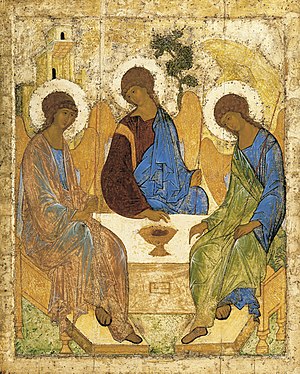
Back أيقونات روسية Arabic Icône russe French Ruske ikone Croatian Icone russe Italian Русская иконопись Russian Руске иконе Serbian

Russian icons represent a form of religious art that developed in Eastern Orthodox Christianity after Kievan Rus' adopted the faith from the Eastern Roman (Byzantine) Empire in AD 988.[1] Initially following Byzantine artistic standards, these icons were integral to religious practices and cultural traditions in Russia. Over time, Russian iconography evolved, incorporating local styles and elements that expanded its visual and symbolic vocabulary.[2]
The personal, innovative and creative traditions of Western European religious art were largely lacking in Russia before the 17th century, when Russian icon painting became strongly influenced by religious paintings and engravings from both Protestant and Catholic Europe. In the mid-17th-century changes in liturgy and practice instituted by Patriarch Nikon resulted in a split in the Russian Orthodox Church. The traditionalists, the persecuted "Old Ritualists" or "Old Believers", continued the traditional stylization of icons, while the State Church modified its practice. From that time icons began to be painted not only in the traditional stylized and non-realistic mode, but also in a mixture of Russian stylization and Western European realism, and in a Western European manner very much like that of Catholic religious art of the time. These types of icons, while found in Russian Orthodox churches, are also sometimes found in various sui juris rites of the Catholic Church.
Russian icons are typically paintings on wood, often small, though some in churches and monasteries may be much larger. Some Russian icons were made of copper.[3] Many religious homes in Russia have icons hanging on the wall in the krasny ugol, the "red" or "beautiful" corner.
There is a rich history and elaborate religious symbolism associated with icons. In Russian churches, the nave is typically separated from the sanctuary by an iconostasis (Russian ikonostas, иконостас), or icon-screen, a wall of icons with double doors in the centre.
Russians sometimes speak of an icon as having been "written", because in the Russian language (like Greek, but unlike English) the same word (pisat', писать in Russian) means both to paint and to write. Icons are considered to be the Gospel in paint, and therefore careful attention is paid to ensure that the Gospel is faithfully and accurately conveyed.
Icons considered miraculous were said to "appear." The "appearance" (Russian: yavlenie, явление) of an icon is its supposedly miraculous discovery. "A true icon is one that has 'appeared', a gift from above, one opening the way to the Prototype and able to perform miracles".[4]
- ^ Sarabianov, V.D.; Smirnova, E.S. The History of Ancient Russian Painting (in Russian). Saint Tikhon's Orthodox University of Humanities. pp. 10–11. ISBN 5-7429-0252-2.
- ^ Sarabianov, V.D.; Smirnova, E.S. The History of Ancient Russian Painting (in Russian). Saint Tikhon's Orthodox University of Humanities. pp. 10–13. ISBN 5-7429-0252-2.
- ^ Ahlborn, Richard E. and Vera Beaver-Bricken Espinola, eds. Russian Copper Icons and Crosses From the Kunz Collection: Castings of Faith. Washington, DC: Smithsonian Institution Press. 1991. 85 pages with illustrations, some colored. Includes bibliographical references pages 84-85. Smithsonian Studies in History and Technology: No. 51.
- ^ Father Vladimir Ivanov (1988). Russian Icons. Rizzoli Publications.
© MMXXIII Rich X Search. We shall prevail. All rights reserved. Rich X Search